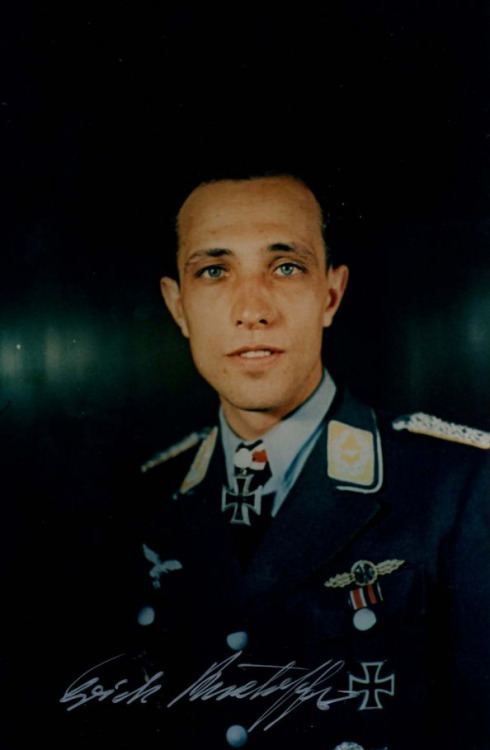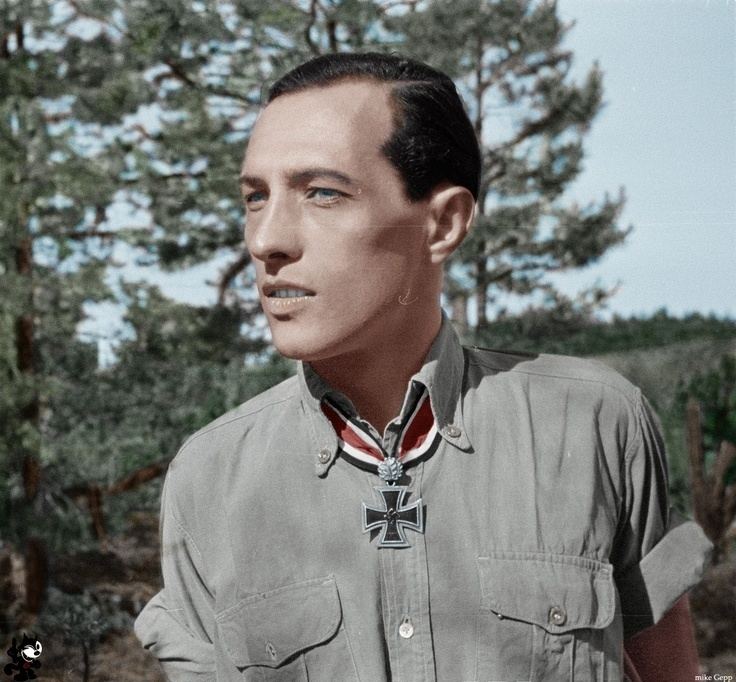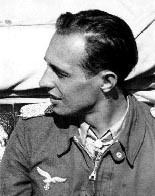Nickname(s) Fighter of Libau Years of service 1939–45 | Name Erich Rudorffer | |
 | ||
Commands held 6. JG 2, II./JG 2, I./JG 7 and II.JG 54 Battles/wars World War IIBattle of FranceBattle of BritainEastern FrontDefense of the Reich Unit Jagdgeschwader 2, Jagdgeschwader 7, Jagdgeschwader 54 | ||
Aces of the Luftwaffe
Major Erich Rudorffer (born 1 November 1917) is a German former Luftwaffe fighter ace, one of a handful who served with the Luftwaffe through the whole of World War II. He is the 7th most successful fighter pilot in the history of air warfare and, since 2014, both the oldest jet fighter ace and the most successful ace still living, as well as the only living fighter pilot with more than 100 victories since the death of Walter Schuck in March 2015. Rudorffer claimed a total of 222 victories, fighting in all the major German theaters of war, including the European and Mediterranean Theatre of Operations and the Eastern Front. During the war he flew more than 1000 combat missions, was engaged in aerial combat over 300 times, was shot down by flak and enemy fighters 16 times and had to take to his parachute 9 times. He distinguished himself by shooting down 13 enemy planes in 17 minutes. His 222 aerial victories include 58 heavily armoured Il-2 Sturmovik ground attack aircraft. He also claimed that he sank a British submarine on 19 May 1941 off the Isle of Portland but Royal Navy losses do not corroborate this claim and the Luftwaffe only credited him with damaging the submarine. Rudorffer is the last living recipient of the Knight's Cross of the Iron Cross with Oak Leaves and Swords.
Contents
- Aces of the Luftwaffe
- FW 190 A4 Obl Erich Rudorffer Tynisia 1943 Eduard 148 by Tolis
- Early life
- World War II
- After the war
- Awards
- References

FW 190 A4 ( Obl. Erich Rudorffer ) Tynisia 1943 - Eduard 1/48 by Tolis.
Early life

Rudorffer was born on 1 November 1917 in Zwochau, at the time in the Kingdom of Saxony of the German Empire. After graduation from school, he received a vocational education as an automobile metalsmith. He joined the military service of the Luftwaffe with Flieger-Ersatz-Abteilung 61 (Flier Replacement Unit 61) in Oschatz on 16 April 1936. From 2 September to 15 October 1936, he served with Kampfgeschwader 253 (KG 253—253rd Bomber Wing) and from 16 October 1936 to 24 February 1937 was trained as an aircraft engine mechanic at the Technische Schule Adlershof, the technical school at Adlershof in Berlin. On 14 March 1937, Rudorffer was posted to Kampfgeschwader 153 (KG 153—153rd Bomber Wing), there he served as a mechanic until end October 1938. He was then transferred to Flieger-Ersatz-Abteilung 51 (Flier Replacement Unit 51) based at Liegnitz in Silesia, present-day Legnica in Poland, for flight training. There he was first trained as a bomber pilot and then as a Zerstorer, a heavy fighter or destroyer, pilot.

On 1 October 1939, Rudorffer was transferred to the Jagdwaffe (fighter force) and was posted to the Jagdfliegerschule 2 (fighter pilot school) at Schleisheim. Following this conversion training, he was transferred to the Jagderganzungsstaffel Doberitz, the supplementary fighter squadron based at Doberitz, on 6 December 1939. On 28 December 1939, he was transferred to the Erganzungs-Jagdgruppe Merseburg, another supplementary training unit stationed at Merseburg, where newly trained fighter pilots received instruction from pilots with combat experience. He stayed there until 7 January 1940, one day later, Rudorffer, now a Oberfeldwebel (staff sergeant), was posted to the 2. Staffel (2nd squadron) of Jagdgeschwader 2 "Richthofen" (JG 2—2nd Fighter Wing) , named after the World War I fighter ace Manfred von Richthofen.
World War II

Rudorffer got his first victory over a Curtiss Hawk 75, on 14 May 1940. He scored eight more times before the capitulation of France. He flew throughout the Battle of Britain, and legend has him being pursued down Croydon High Street below rooftop level by a Hurricane. He achieved his nineteenth victory on 1 May 1941; he was then awarded the Ritterkreuz of the Iron Cross and appointed Staffelkapitan of 6./Jagdgeschwader 2 (JG 2) "Richthofen" the following month. On 19 May 1941, Rudorffer and his wingman attacked a diving submarine off the Isle of Portland. It was observed that both bombs struck close and that the submarine went down vertically. By the end of December 1941 he had claimed 40 kills.
In 1942 Rudorffer participated in Operation Cerberus (Channel Dash) and flew over the Allied landings at Dieppe in August 1942. After 45 victories in November 1942 his unit was transferred south to Sicily and later Tunisia. On 9 February 1943 Rudorffer claimed to have defeated 8 British pilots during a 32-minute aerial battle, and collected his first multiple victories. Again on 15 February he was victorious over 7 allied aircraft. Among his victories over North Africa are 10 Allied bombers.
In July 1943 Rudorffer was appointed to command II./Jagdgeschwader 54 (JG 54) on the Eastern Front. He claimed his first victory in that theater on 7 August. Due to the experience gained by fighting the RAF he achieved incredible success. During his first sortie on 24 August 1943, 5 Soviet aircraft were downed in 4 minutes. On 11 October 1943 Rudorffer made history when during 17 minutes he claimed 13 kills. That day, Rudorffer was also credited with his 100th aerial victory. He was the 55th Luftwaffe pilot to achieve the century mark.
Rudorffer earned his nickname Fighter of Libau on 28 October 1944 near the Latvian city of Libau. While preparing to land he spotted a Soviet task force of about 60 close air support aircraft on its way to attack Libau airfields. He broke off the landing and engaged the enemy without any backup. He drove off the attackers, shooting down nine enemy aircraft within 10 minutes. In the winter of 1944 Rudorffer was trained on the Messerschmitt Me 262 Jet fighter. In February 1945 he was recalled to command I./Jagdgeschwader 7 (JG 7). Between December 1944 and beginning of April 1945 the I./JG 7 operated from the then newly built Luftwaffe Airbase in Kaltenkirchen north of Hamburg. So he seems to have been Group Commander more or less for the one month of March 1945. Rudorffer claimed 12 victories with the Me 262, to bring his total to 222. His tally included 136 on the Eastern Front, 26 in North Africa and 60 on the Western Front including 10 heavy bombers.
After the war
Rudorffer started out flying DC-2s and DC-3s in Australia. Later on he worked for Pan Am and the Luftfahrt-Bundesamt, Germany's civil aviation authority. He is the last living recipient of the Knight's Cross with Oak Leaves and Swords. Rudorffer was one of the characters in the 2007 Finnish war movie Tali-Ihantala 1944. A Fw 190 participated, painted in the same markings as Rudorffer's aircraft in 1944. The aircraft, now based at Omaka Aerodrome in New Zealand, still wears the colours of Rudorffer's machine.
